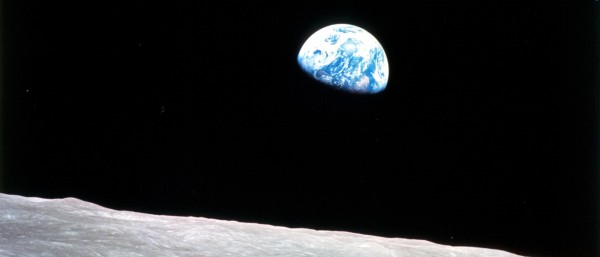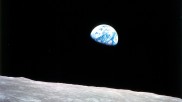Water — the universe is full of it. But only Earth transformed into a blue planet. Water is the source of life, but also a constant threat. An essay about the precious asset of water.
The author

Dr Torsten Meise is a freelance journalist and writes for publications including "Stern", "Mare" and "Spiegel". He focuses on the areas of energy, science and technology.
Read more"Oh, my God, look at that!" was Bill Anders' response on Christmas Eve in 1968. Because as he looked out of the window, he saw something that no human had ever seen before: the Earth rising over the moon's horizon. A blue dot in space, half covered in shadow. Apollo 8 was the first space capsule to orbit the moon. The flight was perfectly planned, but the space mission's photographer hadn't expected this motif, which has gone down in history titled "Earthrise".
The fact that Bill Anders pressed the shutter release button of the only Hasselblad camera on board with colour film forever changed the way we see the Earth. Our radiant blue home planet made an impression on humanity's collective consciousness.
Many people see "Earthrise" as the beginning of the environmental movement. The motif from Apollo 8, Magazine 14/B is frequently described as what may be the most influential environmental photograph in history. Also because no image had ever before shown so clearly and succinctly what makes Earth so unique: a seemingly endless mass of water.
However, pictures can also be misleading. If the Earth was a basketball, all its water would fit in a ping-pong ball. All available freshwater resources would be no larger than a kernel of popcorn. And if the Earth's water were a bathtub, the accessible drinking water would fit in a shot glass. Freshwater reserves only represent 2.53 per cent of the water on Earth. And only 0.3 per cent can be tapped into for drinking water.
Together with two scientists from the United States, Adam Nieman und Howard Perlman, Jack Cook from the Woods Hole Oceanographic Institution set out to represent the planet's known water masses in an illustration. It shows the Earth without water; next to it hovers a blue ball that represents all the water on Earth — about 1.3 billion cubic kilometres. It's so small that it's easy to think that the illustration is fake. But it's accurate.
Oceans, lakes and rivers may cover over 70 per cent of the globe but, compared to the mass of rock and other materials, water only makes up a very small part due to the relatively shallow depth of these bodies of water. The illustration also shows the potentially accessible freshwater reserves necessary to sustain life for people, animals and plants: the kernel of popcorn. Two thirds of the Earth's freshwater are trapped in glaciers and polar regions and are not included here. That's all there is to keep 7.5 billion people alive. Will it be enough in the long run?
It's easy to get completely lost in thought when contemplating water. It has made everything possible on Earth. It surrounds us, is in us, with us and for us, wherever we look. There are traces of water everywhere in the universe. It is the only compound on Earth that exists naturally in all three physical states: as ice, gas and liquid.
The fact that all life comes from water is general knowledge. Before birth, the human embryo swims in a liquid similar to sea water. Up to 96 per cent of this liquid is water. Children's bodies are about 70 per cent water. Over the course of a lifetime, the body dehydrates to about 50 per cent. But one truth always remains: no process in the human body would be able to take place without liquid, without H₂O. All cells consist mainly of water. Transport of nutrients and waste, the circulatory system, glands, lungs, joints, eyes — nothing in the human body functions without water.
The flood is omnipresent
Water, this miracle substance, inspires the imagination and quenches our thirst for knowledge. Thales of Miletus, the famed "Astrologer who Fell into a Well" while gazing into the heavens, established the age of scientific philosophy around 2600 years ago, despite his clumsiness. Because the philosopher did not leave behind any written work, we can only speculate when and how he came to believe that all life had its origin in water. Perhaps outside his own front door, while looking into the lovely Ionian Sea. Or maybe at the damp bottom of the well.
His intuition was right. And he wasn't far off from the great world religions, which all give water key significance during the creation of humanity and Nature. And it's hardly surprising.
Human life is inextricably linked with water. It is vital. Ten thousand years ago, when our ancestors ended their nomadic existence to create settlements, they settled where freshwater was available: by rivers and lakes. And water thus became the most important player in the drama of survival. Because rivers can dry up or flood their banks if the cycle of condensation and precipitation falls out of sync.
Droughts and floods are among humanity's primal fears, and stories of these events can be found in nearly all the world's religions. The very first written records from early civilisations in Mesopotamia focus on the Flood. The Sumerian epics were integrated into the ideas contained in the Jewish, Christian and Islamic Genesis traditions. Mythologies from India, China and even indigenous peoples in the Americas also contain their own Flood narratives.
Water means power
A few years ago, Roman Polanski's movie "Chinatown" (1974) was selected as the best crime film of all time by British critics. In it, speculator Noah Cross, played by John Huston, redirects water away from the farms surrounding Los Angeles. Then he purchases the land at a cheaper price and waits for the growing city to buy it from him for inflated prices. The screenplay was originally titled "Water and Power", based on the California Water Wars, a series of conflicts in the early 20th century that led to corruption, crime and the decline of entire valleys in the area surrounding the Hollywood dream factory. The issue of water is still critical in California today.
Since 2011, a drought has depressed the region, which is not only home to Hollywood, but also to Silicon Valley. The interests of cities, farmers and corporations continually clash here. The "New York Times" recently reported about the small town of Weed in Northern California. A lumber company claims the spring that provides the town's drinking water as their property and now wants to sell the water to a bottled water company. The residents of Weed were told to find another water source. However, the US has some of the most abundant water resources in the world, so water should not actually be a problem. Actually.
California is everywhere. Even Hamburg is at loggerheads with Nordheide because of water. "Water Wars" has become a term for the series of conflicts that are simmering around the world. Reports of conflicts are becoming more frequent: between India and Pakistan, Tajikistan and Kazakhstan, Uzbekistan and Turkmenistan, Jordan and Saudi Arabia, and in many other regions of the world. For the most part they are still cold wars and, fortunately, have not yet fully unleashed their dangerous potential. Even in 1985, UN Secretary General Boutros Boutros-Ghali predicted that "the next war in the Middle East will be fought over water, not politics." As we know, this prediction was not correct, but that doesn't mean that the general prognosis is wrong.
Drinking water as a fundamental right
When detective J.J. Gittes (Jack Nicholson) asks villain Noah Cross in "Chinatown" what his motivation is behind the crimes, the answer is: "The future, Mr Gittes, the future!" Drinkable water is the future. And it is a scarce resource on the blue planet. According to UNICEF and the World Health Organization (WHO), 663 million people currently do not have access to clean sources of drinking water and 2.5 billion people do not have access to appropriate sanitation. The resulting diseases kill more children than malaria, measles and AIDS combined. The lack of water not only fans conflicts, it also causes potential to lie dormant that is needed to create a better world.
The United Nations estimates that women worldwide spend more than 40 billion hours gathering water. Countless girls do not attend school in the poorest countries because they spend the entire day searching for water. What a waste. The United Nations adopted Resolution 64/292 in 2010, which recognised "the human right to water and sanitation and acknowledged that clean drinking water and sanitation are essential to the realisation of all human rights".
The UN decision will have long-term effects and ensure more involvement from the global community. According to the German Federal Government, investing one euro in this area can increase the gross domestic product in developing countries by eight euros. By the way, when it comes to drinking water, a great deal has already happened. According to estimates from UNICEF, 91 per cent of all people have access to clean water today; that's 2.6 billion more than in 1990.
But just when there is a spark of hope, another danger is already looming: climate change. As the ice cover in Greenland and the Antarctic melts, and the water spreads throughout the warming oceans, the sea level is rising irreversibly. And it is threatening the places where the most people live, the largest megalopolises on the coasts: New York, Los Angeles, Rio, Mumbai, Shanghai, Hong Kong, Tokyo, Sydney, Lagos, Jakarta, Singapore and many others.
Since the beginning of the 20th century, the sea level has already risen 20 centimetres. The risk of losing large sections of densely populated coastline to the ocean in certain corridors has been projected. According to the Intergovernmental Panel on Climate Change, the sea level is rising with increasing speed. It is currently rising at over three millimetres per year, more than twice as fast as at the beginning of the 20th century. That is a flood in slow motion, one with a message.
Has a new age begun?
Because humanity has learned to survive droughts and floods, there is an illusion that a world emancipated from its natural conditions, or from its "well", has developed. Scientists are currently involved in a heated debate about whether we have already entered a new geological era, the Anthropocene.
The "human age" is characterised by the fact that changes on the planet are no longer driven by natural influences like wind and water; Instead they are driven by human activities. This includes pollution and management of rivers, construction of irrigation canals across hundreds of kilometres, consumption of ground water resources and aquifers, vast urbanisation and the associated infrastructure, and finally, climate change as well, with the loss of glaciers and coastal regions.
For Germany, the largest problem is anthropogenic pollution of ground water — with nitrates in a third of the Federal Republic and the legacy of the mining industry in the Ruhr area. While civilisation has moulded the planet little by little, water has been and will continue to remain a critical aspect throughout the ages. It remains the medium of existence and potential, but also a catalyst for discovery and a constant reminder of how perilous life is. Or, as Bill Anders said: "Oh, my God, look at that!"
Published on KfW Stories on 24 July 2017, updated on 17 March 2022.






Data protection principles
If you click on one of the following icons, your data will be sent to the corresponding social network.
Privacy information